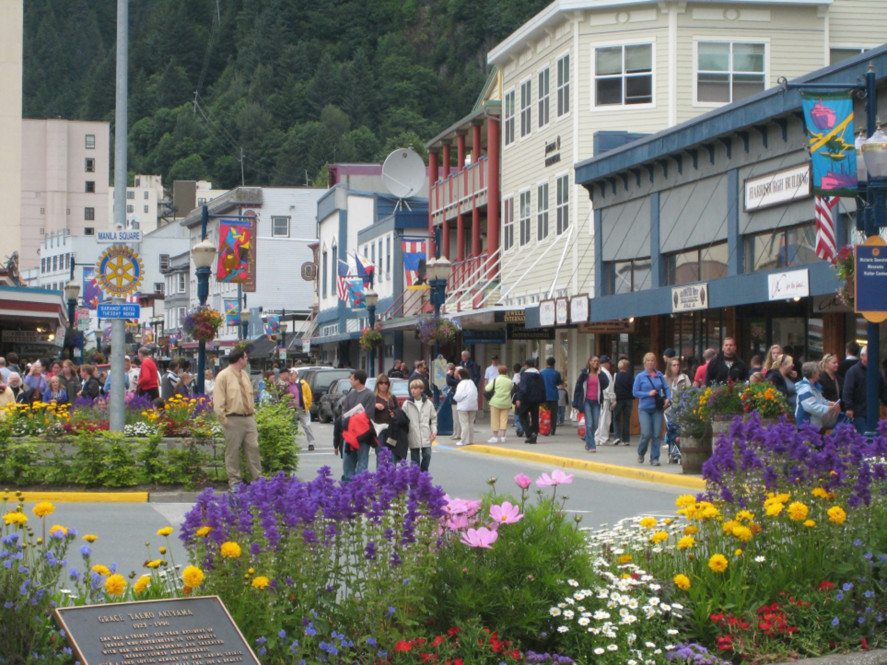When it comes to conversations around Alaska’s unique geography, Alaska trivia, fun facts and unusual statistics are dependably fascinating and practically infinite!
For example:
- What’s the distance of the Iditarod Trail Sled Dog Race? ALASKA ANSWER: The traditional route is 1,149 miles.
- What’s the proper name of the state’s great mountain: McKinley or Denali? ALASKA ANSWER: Alaskans and the federal government agree, the 20,310-foot peak is Denali.
- Just how big is America’s biggest state? ALASKA ANSWER: 663,268 square miles – more than twice the size of Texas.
One discussion often entertained by Alaskans and state visitors alike is the Juneau question.
- Why is Alaska’s state capital and government epicenter located in the beautiful but remote and rainy Southeast town of Juneau, hundreds of miles from Alaska’s road system and the majority of its residents?

Whale Watching Lynn Canal near Juneau
There is no question that Juneau is one of our state’s urban gems. And stunning landscapes and scenery surround it: massive glaciers, tall trees, jutting mountain backdrops, countless waterways and abundant wildlife, from bears to whales to eagles. But without question, those same epic landscapes make Juneau really difficult to get to.
For example, you can’t drive to Juneau. You have to fly in and it is nearly 600 air miles from Anchorage and only 900 miles from Seattle. You can also get to Juneau by boat, but unless you’re aboard a cruise ship or ferry, or you are a very skilled captain with a capable vessel, it’s not a recommended route.
So why exactly is the state’s capital located in a place that’s so inaccessible to most Alaskans and visitors alike?
Short Alaska answer: that’s the way it’s always been. Well, since 1906 at least, 53 years before statehood. Back then, Alaska was a U.S. Territory and Juneau was a hopping Gold Rush town (it is named after Canadian miner Joe Juneau) and popular fishing area for the region’s Alaska Native people.
Today, Juneau remains relevant thanks to tourism and its government roots. Quaint and vibrant, the Juneau area has more than 30,000 year-round residents who host one million cruise ship visitors during the summer.

Visitors exploring downtown Juneau.
Among the Alaska residents are state government employees whose offices operate out of Juneau (though some staff and departments are now based in Anchorage or strategically spread out across Alaska). Juneau’s tiny downtown is the hub of state government. That’s where you’ll find the State Capitol, which houses the Office of the Governor, Alaska Senate and House of Representatives chambers and more than 20 legislative offices. Alaska’s legislators, as well as numerous aides, lobbyists and media members, gather in Juneau every session starting in January. Juneau is also home to museums that exhibit especially exceptional Alaska artifacts.
Since statehood in 1959, numerous grassroots campaigns and a handful of ballot propositions have attempted to officially move the state capital in Alaska to a more reachable residence – usually Anchorage, Wasilla or Willow in the Matanuska-Susitna Valley. Those relocation efforts have either been voted down or sidelined by the high price of making such a monumental move.
That argument has quieted in recent years anyway, as technology has made the state government’s staff and its work just a few clicks away from anywhere in Alaska. There are live statewide television feeds of government meetings and hearings. The progress of bills and laws are updated in real time online and via cell phone apps. Most legislators, state directors and even the governor can be easily reached by phone, email or tweet.
And so it is that Alaska’s capital remains in Juneau, one of the nation’s most isolated and breathtaking capitals, steeped in historic significance, local color and staggering natural beauty.
